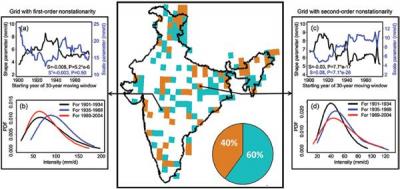
Indian summer monsoon rainfall (ISMR) is the major component of the Asian summer monsoon, which provides an 80% of the total annual rainfall in India, from June to September, which is critically important for agricultural productivity and GDP. However, global and local environmental changes are likely to introduce non-stationarity in the characteristics of ISMR extremes. Hence, it will be useful to understand the possible impacts of local changes on rainfall extremes and in projecting these changes into the future by considering the feedback of urbanisation in climate change projections.Here, we perform a non-stationary frequency analysis on ISMR extremes in a generalised additive model for location, scale and shape framework with a cluster of 74 models, considering non-stationarity in different possible combinations. Interestingly, we observe significant non-stationarity in ISMR extremes in urbanising / developing-urban areas (transitioning from rural to urban), compared to completely urbanised or rural areas. This presents a postulation that the extent of urbanisation plays a significant role in introducing non-stationarity in ISMR extremes.The results from present study will be useful in understanding the possible impacts of local changes on rainfall extremes and in projecting these changes into the future by considering the feedback of urbanisation in climate change projections. The study thus has great relevance in the context of adaptation and policy formulation, especially under the impact of urbanisation and climate change in urbanised, urbanising, and rural areas in Indian subcontinent.
Prof. Subhankar Karmakar
